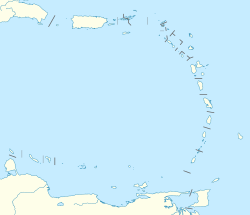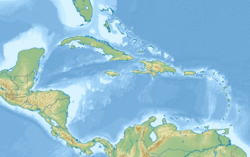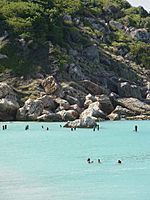Caja de Muertos Island facts for kids

Isla Caja de Muertos, Ponce Puerto Rico, looking southeast from Puerto Rico's mainland southern shore
|
|
|
Caja de Muertos, Puerto Rico
|
|
| Geography | |
|---|---|
| Location | Ponce, Puerto Rico |
| Coordinates | 17°53′41″N 66°31′8″W / 17.89472°N 66.51889°W |
| Area | 1.54 km2 (0.59 sq mi) |
| Length | 2.75 km (1.709 mi) |
| Width | 0.86 km (0.534 mi) |
| Highest elevation | 52 m (171 ft) |
| Administration | |
| Commonwealth | Puerto Rico |
| Municipality | Ponce |
| Barrio | Playa |
Caja de Muertos is an amazing, uninhabited island off the southern coast of Puerto Rico. Its name means "Chest of the Dead" or "Deadman's Chest" in English. This special island and the waters around it are a protected Caja de Muertos Nature Reserve.
It's a safe home for native turtles and has important dry forests and coral reefs. Many people visit Caja de Muertos to hike and enjoy the beaches. You can get there by ferry from Ponce. Caja de Muertos is one of seven islands that belong to the city of Ponce.
Contents
Discovering the Island's Past
Caja de Muertos is thought to be about 4,000 years old. Ancient stone art shows that people have visited it for thousands of years!
Early Visitors and Hidden Treasures
The Taíno people, who lived in Puerto Rico long ago, often went to the island to fish. Later, in the 1600s, pirates and rebellious sailors used the island as a secret hideout. One famous story tells of merchants who became pirates. They stole treasure from a Portuguese ship, but then faced a mutiny. They hid on Caja de Muertos with their treasure. When they went to the mainland for supplies, they were caught, and the treasure was found!
Lighthouses and Famous Stories
In 1842, the first map showed the island with its current name. The Spanish government built a lighthouse there, finishing it in 1887. This lighthouse still stands today!
During the 1800s, the island was also a secret meeting place for Puerto Rican patriots who wanted independence from Spain. Famous writers were even inspired by Caja de Muertos. Cayetano Coll y Toste wrote a novel called "The Treasure of Pirate Almeida" in 1928. Even more famously, some believe that the island inspired Robert Louis Stevenson to write his classic novel, "Treasure Island", in 1883!
From Residents to Nature Reserve
In 1898, about 64 people lived on the island. They had no fresh water, so it had to be brought from the mainland. Over time, the island became uninhabited, except for the lighthouse keepers. When the lighthouse became automatic in 1945, there was no longer a need for keepers, and the island became deserted.
After that, people with private boats started visiting for day trips and fishing. On January 2, 1980, the island was officially declared a nature reserve. This means it's a protected area, managed by the Puerto Rico Department of Natural Resources and the Ponce government. The old lighthouse was even restored and used to have a museum.
Challenges and Reopening for Visitors
For a while, there was public transportation to the island, and later, private companies offered daily trips. However, the ferry service was stopped twice after big natural disasters: Hurricane Maria in 2017 and the 2020 Puerto Rico earthquakes. Both events badly damaged the main boarding area on the mainland.
Despite these challenges, the government has worked to rebuild. They built a new dock, housing for park staff, a small museum, and trails for tourists. By 2012, several businesses were offering tours to the island. In 2010, Pelícano Beach even received a special "Blue Flag" award for its cleanliness and safety!
Recently, the reserve faced difficulties, with fewer rangers to protect it. This led to some visitors breaking rules, like anchoring in forbidden areas or having parties. It also affected efforts to protect the hawksbill sea turtle, an endangered species. However, officials are working to fix these issues and get more funds to rebuild and protect this special place.
Where is Caja de Muertos?
Caja de Muertos is located about 5.2 miles (8.4 km) south of the main island of Puerto Rico. It is part of the Playa area in the Ponce municipality.
Island Geography and Weather
The island is about 2 miles (3.2 km) long from northeast to southwest. It is about 2,822 feet (860 meters) wide. Its total area is about 0.59 square miles (1.54 square kilometers).
Close by are two smaller keys: Morrillito Key and Berbería Key. Both are also part of the Caja de Muertos Natural Reserve.
The island has a dry climate, which means it doesn't get much rain. Because of this, it has a special type of dry forest. The old lighthouse, built in 1887, sits on the highest hill on the island, which is about 170 feet (52 meters) high.
What Makes Caja de Muertos Special?
Caja de Muertos has four beautiful beaches: Pelicano, Playa Larga, Carrucho, and Coast Guard. The island is also home to unique plants and animals that you might not find anywhere else in the world!
Even though no one lives on the island permanently, the Government of Puerto Rico has staff and security personnel there to protect it.
The Mystery of the Name
Over the years, Caja de Muertos has had many different names, like Isla Abeiranas, Isla Bestia, and Isla del Tesoro (Treasure Island). It has also been called "Coffin Island" or "Deadman's Chest" in English.
No one is completely sure how the island got its current name. The official story from the Puerto Rico Department of Natural Resources says that an 18th-century French writer, Jean-Baptiste Labat, called it Coffre à mort (Caja de Muertos). He said that when you look at the island from certain places on the southern coast of Puerto Rico, it looks like a dead person lying down.
Fun Theories About the Name
The Pirate's Sad Story
One popular story is about a Portuguese pirate named José Almeida. He fell in love and got married, but sadly, his wife was killed during his first pirate raid. Heartbroken, Almeida had her body preserved and placed in a glass box inside a copper coffin. He buried her in a cave on a deserted island near Ponce. Every month, he would visit her grave and leave half of his treasure there.
Almeida was eventually caught and executed in 1832. Many years later, a Spanish engineer supposedly found the glass and copper coffin. When he saw the island on a map, he named it "Caja de Muertos" because of the coffin. The treasure, if any was found, was kept a secret!
A Shipwreck and Hidden Riches
Another story from 1599 tells of English merchants who turned into pirates. They captured a Portuguese ship full of gold, silver, and jewels. After losing their main ship and many crew members, they decided to return to England. But first, they took refuge on Caja de Muertos.
One of the Englishmen was captured on the mainland and told authorities about the hidden treasure. This led to a search for the treasure. The Spanish took the treasure, and from these events, the island supposedly got its name, "Isla de Caja de Muertos" (Dead Man's Chest).
Caja de Muertos Nature Reserve
Caja de Muertos was made a nature reserve in 1980. This happened after a special meeting decided it should be a protected wilderness area. It has been protected ever since, mainly because it's a very important nesting site for endangered sea turtles.
Beautiful Beaches to Explore
The island has five lovely beaches for visitors to enjoy:
- Playa Pelícano
 - This beach is on the western side of the island, where boats usually dock. It has even received a special "Blue Flag" award!
- This beach is on the western side of the island, where boats usually dock. It has even received a special "Blue Flag" award! - Playa Ensenadita (also called "Pocitas")
- Playa Larga - This beach is on the southeastern side of the island, facing the open Caribbean Sea. It's a protected area, so visitors can't access it.
- Playa Blanca (also called Playa Coast Guard) - You'll find this beach on the northwest side of the island, facing the city of Ponce.
- Playa Chica (also called Playa Carrucho) - This beach is located on the northern and northeastern end of the island, looking towards the main island of Puerto Rico.
Images for kids
See also
 In Spanish: Isla Caja de Muertos para niños
In Spanish: Isla Caja de Muertos para niños







